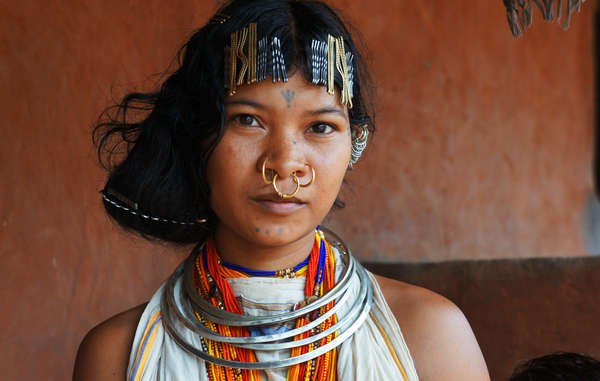
by Deep Green Resistance News Service | May 10, 2017 | Colonialism & Conquest, Mining & Drilling
Featured image: The Dongria have resisted attempts to mine in their hills for years, but are facing serious pressure to give in. © Survival International
by Survival International
The Indian government is harassing and attempting to silence the leaders of the Dongria Kondh tribe, famous for winning a “David and Goliath” court battle against a British mining giant.
The Dongria’s resistance to mining on their lands has continued since their landmark victory in 2014. Leaders including Dodi Pusika feel that the risk of mining remains as long as a refinery is operational at the foot of the Niyamgiri hills, an area which the tribe have been dependent on and managed for generations. A recent protest at the refinery was met with a baton-charge from police.
Pusika’s daughter-in-law, Kuni Sikaka, was arrested in the middle of the night of May 3 and accused of links with armed Maoist rebels. In exchange for her release, Dodi Pusika and other members of his family were made to “surrender” as Maoists and paraded in front of the media.
There has been an alarming increase in arbitrary, politically motivated arrests of tribal people who are resisting mining operations or government policies which endanger their lands and communities. Typically, those arrested are accused of Maoist links – usually without evidence.
Human rights activist and doctor Binayak Sen and tribal teacher Soni Sori have both been imprisoned for alleged Maoist connections and only subsequently released after national and international campaigns.
In April, the Home Ministry issued a report claiming that Maoists were “guiding the activities” of the Dongria’s organization, the Niyamgiri Suraksha Samiti (NSS). On the contrary, Maoists instructed the Dongria to boycott the very meetings at which they delivered their decisive “no” to mining.
Lingaraj Azad, a member of the NSS, stated, ‘We have always opposed violence – either State violence or Maoist violence. We will not bow down, but continue our struggle to protect Niyamgiri from being mined.’
Survival International is calling on the government to drop these fabricated charges, stop this persecution of the Dongria Kondh, respect their decision about the Niyamgiri mine, and to uphold their right to protect their lands and determine their own futures.
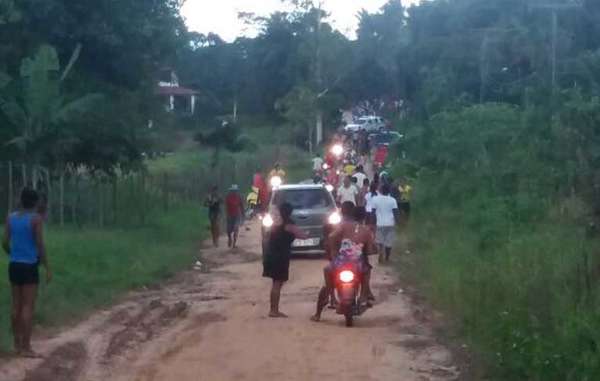
by Deep Green Resistance News Service | May 4, 2017 | Colonialism & Conquest
Featured image: Cellphone photo shows the ranchers on their way to attack the Gamela. A police car accompanies them. © CIMI
by Survival International
Warning: Graphic photos
Thirteen Brazilian Indians have been hospitalized after a brutally violent attack by men armed with machetes in the Amazon.
One man appears to have had his arms severed in disturbing photos released to Survival International.
The attack was in retaliation for the Gamela Indians’ campaign to recover a small part of their ancestral territory. Their land has been invaded and destroyed by ranchers, loggers and land grabbers, forcing the Gamela to live squeezed on a tiny patch of land. The Gamela are indigenous to the area in Maranhão state in northern Brazil.
Powerful agribusiness interests – reportedly including the Sarney landowning family – have been in conflict with the tribe for some time. The family includes a former president of Brazil and a former governor of Maranhão state.

Photo of a victim of the attack, sent to Survival by Brazilian NGO CIMI. © CIMI
Eyewitnesses say that the ranchers gathered at a barbecue to get drunk, before surrounding the Gamela camp, firing guns, and then attacking with machetes, causing grievous injuries. Local police are reported to have stood by and allowed the attack to happen.
The Gamela have received death threats in response to their attempts to return to their land. In a declaration released by Brazilian NGO CIMI, they said: “People are mistaken if they think that by killing us they’ll put a stop to our fight. If they kill us, we will just grow again, like seeds… Neither fear nor the ranchers’ bullets can stop us.”
The attack came just days after massive indigenous protests in Brazil’s capital against proposed changes to Brazil’s indigenous laws, which could have disastrous consequences for tribal peoples.
Land theft is the biggest problem tribal peoples face. Around the world, industrialized society is stealing tribal lands in the pursuit of profit.
Campaigners fear that the close ties between Brazil’s agribusiness lobby and the Temer government installed after the impeachment of Dilma Rousseff in 2016 could lead to further genocidal violence and racism against Brazilian tribal peoples.
Survival’s Director Stephen Corry said: “Right now, we’re witnessing the biggest assault on Brazilian Indians for the last two generations. This truly horrific attack is symptomatic of a sustained and brutal onslaught which is annihilating indigenous communities across the country. Heinous acts like this won’t end until the perpetrators are prosecuted and Brazil starts enforcing tribal land rights as it should do under national and international law.”
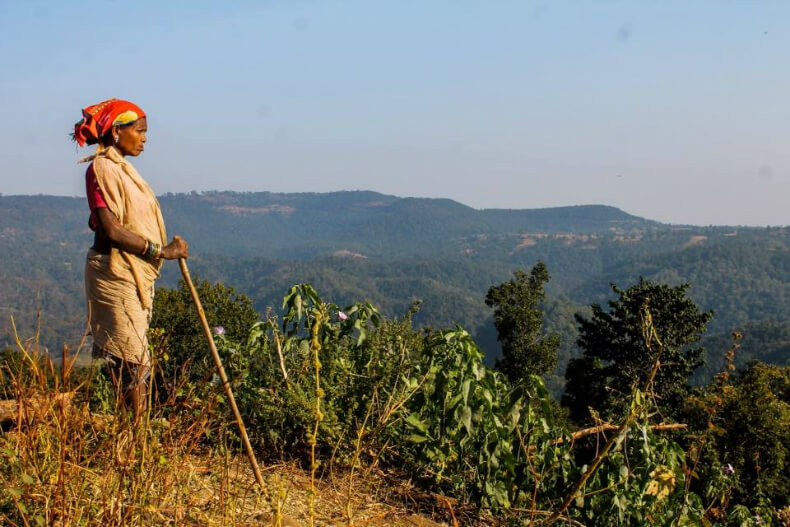
by Deep Green Resistance News Service | Apr 30, 2017 | Colonialism & Conquest
Featured image: A Baiga woman surveys the land in Amaniya panchayat, Chhattisgarh, much of which falls in the area of the proposed tiger corridor between Kanha and Achanakmar National Parks. In the tribal belt of central India, indigenous communities are being manipulated, evicted, and impoverished in the name of conservation. Photo: Heera Bai.
by Heera Bai / Intercontinental Cry
Throughout India today there are a total of 645 Adivasi communities recognized by the government. With a combined population of about 70 million, these communities maintain an impressive array of cultural identities, languages, customs and economies that go back millennia. But despite their resilience and their relative isolation from the perils of extreme extraction, Adivasis—the Hindi term for Indigenous Peoples—have not been able to escape any of the hardships that other Indigenous Peoples so often face around the world.
Across the Tribal Belt of Central India, where 90 percent of the population is still completely dependent on agriculture, indigenous communities are constantly being evicted from their ancestral lands to make way for development projects, industry, tourism and government-sanctioned conservation initiatives.
In the states of Madhya Pradesh and Chhattisgarh, the Baiga community have faced a legacy of evictions that dates back more than 30 years. They are constantly being forcefully, and often illegally, relocated from their fields and villages that live in and around the borders of the Kanha and Achanakmar National Parks.
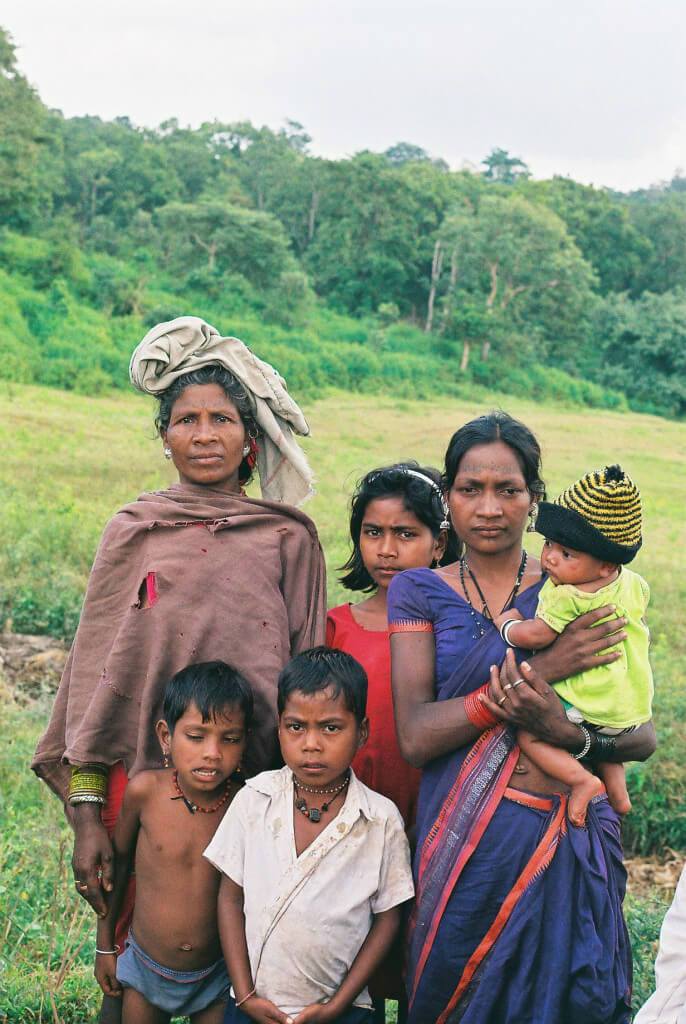
Women from Hirapur, a Baiga village which was relocated from Kanha National Park in the 1970s. “This lush green jungle – we can only see it, but we cant touch it. We cant take anything which was our traditions, our daily bread, it was everything to us. Our rights are written down in a book but we are illiterate.” Photo: Heera Bai
The Baiga are classified as a Particularly Vulnerable Tribal Group (PVTG) by the Indian Government, and the present adult generation had little access to education. The majority are illiterate and know no other language than their regional dialect. Their villages are incredibly isolated, accessible only by foot or motorbike on tracks through the forest. The distance between these villages makes cross-community solidarity or resistance logistically difficult, increasing their vulnerability to exploitation.
Until recently, the Baiga community was dependent on the jungle and the surrounding environment for survival. However, they existed in a symbiotic relationship with the forest generously providing them with everything they need including food, ‘jhari-booti’ (jungle medicine) and wood to build homes and tools. However, after decades of increasing rules and restrictions placed on their access to forest resources and the criminalisation of practices such as ‘bewar’ (shifting cultivation), their way of life has become increasingly difficult to maintain.
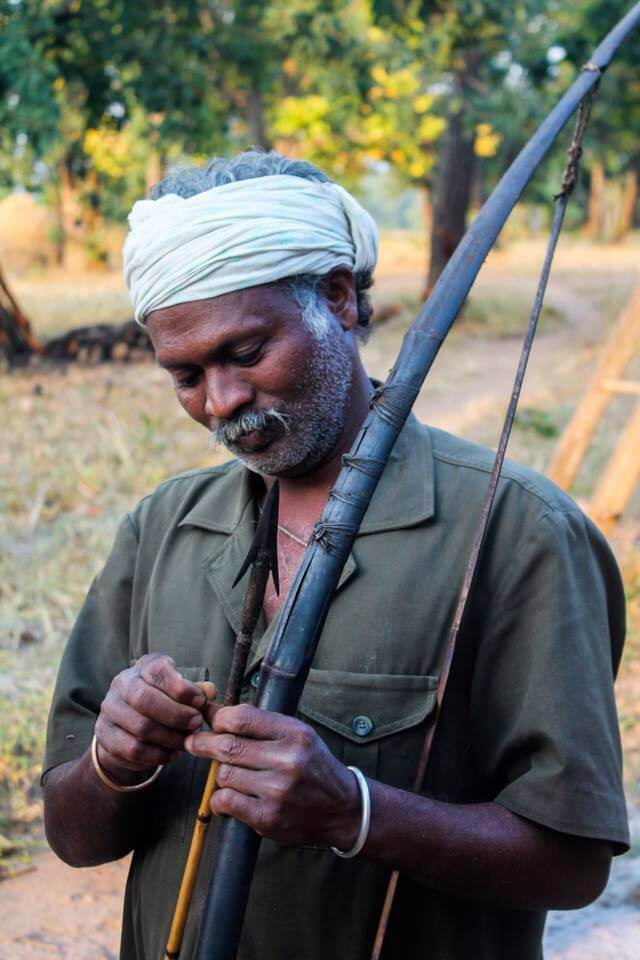
Noonsari, the makeshift village of displaced Baiga adivasi, in Mawai district Madhya Pradesh. This is a dhanoosna, a weapon used by their ancestors for hunting in the jungle. It takes a whole day to make a single arrow from peacock feather and cartilage. Photo: Heera Bai
“For us, only the jungle for us is good,” Bazaari Singh Baiga of the Peepatola village in Chhattisgarh said. “We don’t want fields or houses in another place. We want to stay living in the jungle, we don’t want to move to a city, where would we get wood from? We get everything we need from the jungle. If we moved from here we would die very quickly! We don’t buy things, we take everything from the jungle and make things ourselves with our own hands.”
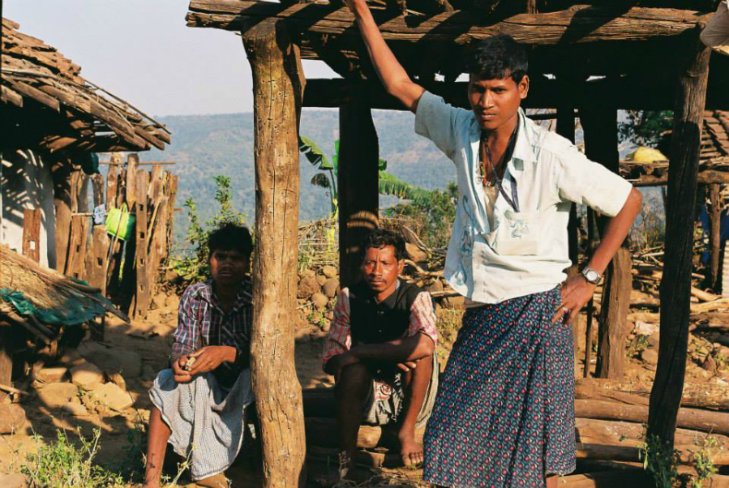
“We don’t want fields or houses in another place. We want to stay living in the jungle, we don’t want to move to a city, where would we get wood from? We get everything we need from the jungle,” says Bazaari Singh Baiga. Photo: Heera Bai
All Baiga villages in Kanha National Park in Madhya Pradesh have been displaced. The evictions began in the 1970s and the last five villages were evicted in 2013. It is a legal requirement that villagers give free, informed consent to the relocation of their village, but consent is forcefully taken after threats, harassment and manipulation.
“The Forest Department came and told us that if we don’t leave willingly they will bring elephants to trample our homes and fields,” Shakti Baiga said. Baiga lived in Benda, one of the last villages in Kanha evicted in 2013. “They brought documents into the village and made us sign it. But we’re illiterate, how could we have known that we were signing our land away?
“I had 5 acres of land in Benda. Here, I could only afford to buy 1.5 acres to support my whole family. I could only afford this land because chances are, this village will be also displaced in the near future. A new [Bhoromdeo] Wildlife Sanctuary has now been created and the fences are starting to go up around the village… There are only two families from Benda here, I don’t see any of the original community anymore.”
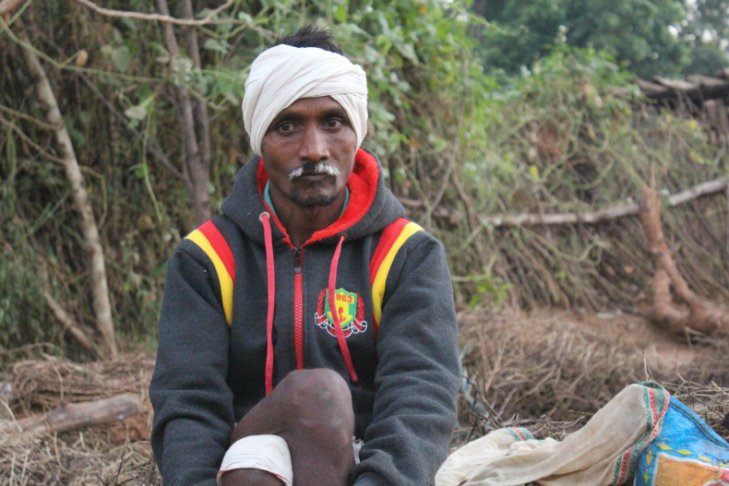
“How could we have known that we were signing our land away?” asks Shakti Baiga. Photo: Heera Bai
There is a strong World Wildlife Federation (WWF) presence in both parks. The infamous panda logo is seen in across the region, from the gates of the national park to small forest villages on the edge of the buffer zone. Despite denying any vested interest in tourism in Kanha, they offer $8,995 ‘tiger tours.’’ Survival International has confronted them about their complicity in illegal evictions in the National Park, but they have denied the illegality of these displacements.
The Forest Rights Act, implemented in 2006, supposedly recognizes ‘any traditional right customarily enjoyed’ by any ‘forest dwelling Scheduled Tribes’ or ‘Traditional Forest Dwellers’. These rights include not only those of forest habitation, but also ‘the right to cultivate for their livelihood, the right to collect minor forest produce, the right to graze cattle, the right to convert leases or grants (pattas) to titles, the right to manage the community forest resources, and the right to enjoy any customary/traditional practice.’
The Forest Rights Act also stipulates procedures for evicting a community from its land. The Panchayat Extension to Scheduled Areas (PESA) means that the Gram Sabha (village level decision making body) must give full, informed consent to the displacement. The community are supposed to be given three options: 1) Reject the eviction and stay on their land, 2) Agree to the eviction, and accept 10 lakh Rs in compensation, or 3) Agree to eviction, and move to a government provided Resettlement and Rehabilitation site.
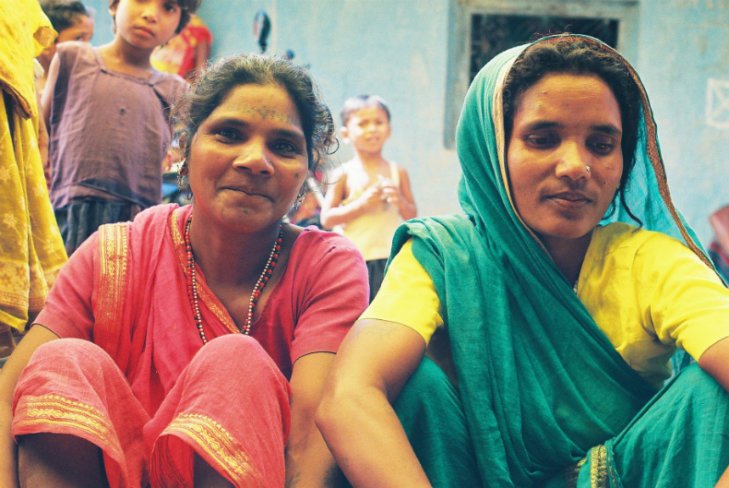
Maki Bai and Sombati Bai from Ajanpur (displaced, now squatting on land in Bhari village, Madhya Pradesh) “All the land that was ours before, where are we going to find that now? We won’t find it. we were the kings of the jungle, but here they treat us like dogs. It’s only sadness here. We can’t even taken wood. Our lives are like dogs!” Photo: Heera Bai
There is no evidence in any of the Baiga villages evicted in the Kanha National Park were given any choice in the relocation, no village was given the option to stay. Even when a rejection is given, this is manipulated; a ‘no’ at the village level gram sabha becomes a ‘yes’ at higher levels of government.
In recent years, the government has run out of state land around Kanha National Park to offer the evicted communities as part of a Resettlement and Rehabilitation package. Villagers from Johar, Benda and the three other villages that were evicted in 2013 received just 10 lakh per adult male, in compensation (women and children under 18 are entitled to nothing). Now, they are struggling to find land that they can afford to buy and the communities have scattered across the region.
In the second park, Achanakmar National Park in Chhattisgarh, there are still 19 tribal villages inside the Core Zone, and many more in the Buffer Zone. So far, five villages have been evicted from the Core, and five more have been given their eviction notice. Those evicted were rehabilitated in resettlement villages on the outskirts of the National Park, where the concrete houses and the dusty road is a far cry from the lush green surroundings they left behind. They were promised five acres of land, a home, a village school and two years of paid work. The fields are drying up after just two harvests, after two years the school building is still awaiting completion and the promised work is yet to materialise. Men of the village are starting to go to distant cities like Lucknow in order to find menial, exploitative daily wage labour.
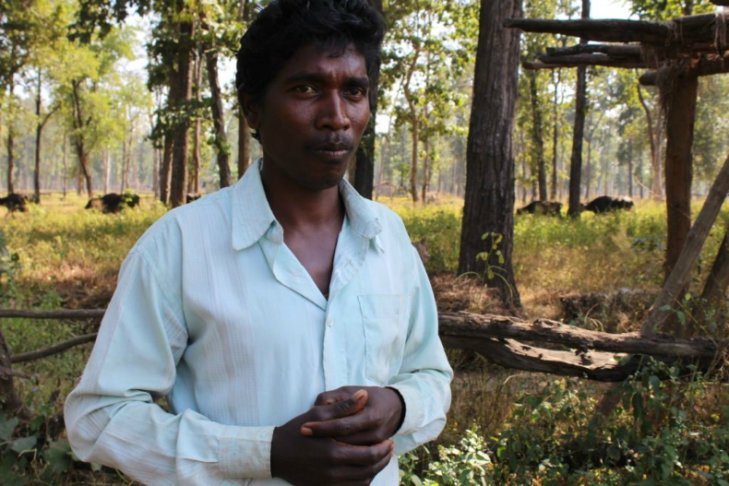
“If we have no choice but to leave Rajak, then we will only be relocated to Jhiriya Behera,” says Ramcharan Baiga. Photo: Heera Bai
Villagers still living in the forest have seen the resettled villages and refuse the offer of relocation. In Rajak, a core zone village, the villagers are unanimous in their rejection of the displaced and the proposed resettlement site. “Of course we want to stay in our village,” Ramcharan Baiga, a residents of Rajak, said. “If we can stay, then we will. We have told the District Collector that we will not go to Bharatpur because the land there is not sufficient to support our families. If we have no choice but to leave Rajak, then we will only be relocated to Jhiriya Behera.” The District Collector is refusing this compromise and insisting that the villagers have no choice in their resettled location.
The National Tiger Conservation Authority (NTCA), Ministry of Environment and Forests, have recently and surreptitiously passed an order stating that:
“In absence (of) guidelines for notification of critical wildlife habitats, no rights shall be conferred in Critical Tiger Habitats which is duly notified under the Wildlife (Protection) Act 1972.”
The Forest Rights Act states explicitly that the rights conferred within apply to all forest areas without exception; therefore the attempt by the NTCA to bypass this is illegal, and will be devastating for the communities affected. There is mounting evidence that suggests that the presence of Adivasis in critical wildlife habitats, including tiger reserves, is in fact conducive to preserving and managing these areas of biodiversity.
In addition to this, there are also plans to create a ‘tiger corridor’ between Kanha and Achanakmar. There are over 700 villages in the proposed area, and many residents do not even hold the most basic land titles. Their evictions will be quick and they will have no grounds to resist. WWF and the state government have assured people that there will be no evictions in the area, but local people do not believe this at all. There are villages about every 7 km in the proposed corridor area, meaning that tigers will not be able to move through the ‘corridor’ without presenting a huge threat to villages. Therefore locals have come to conclusion that the reassurances they have had about there being no evictions are not true.
“That’s what they said when Kanha became a national park, they said the same for Achanakmar. They have already started putting up fences and restricting people’s access to the forest,” said Naresh Bunkar, a local man who was been working with adivasi communities in the region for 30 years. “It’s all lies. Slowly slowly, everyone here is going to be evicted.”
Heera Bai is a freelance journalist who works at Brush & Bow, a platform for creative journalism, working on documenting individual stories through art and music. Follow them at brushandbow.com and on Twitter @brushandbow2
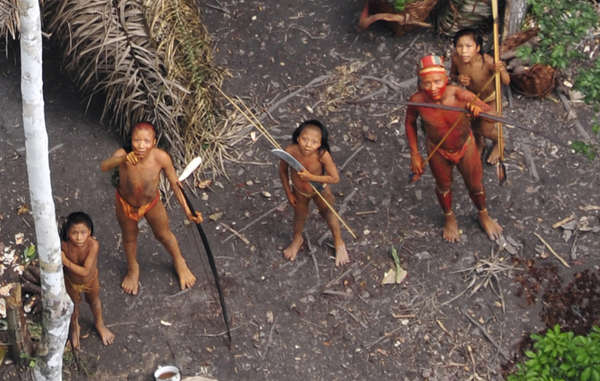
by Deep Green Resistance News Service | Apr 26, 2017 | Colonialism & Conquest
Featured image: Uncontacted tribes, like this one pictured in aerial footage seen around the world in 2011, now face genocidal attacks as Brazil’s government slashes funding for protection of their land. © G.Miranda/FUNAI/Survival
by Survival International
All the government units currently protecting Brazil’s uncontacted tribes from invasion by loggers and ranchers could be withdrawn, according to information leaked to Survival International. The move would constitute the biggest threat to uncontacted Amazon tribes for a generation.
Agents from FUNAI, the country’s indigenous affairs department, perform a vital role in protecting uncontacted territories from loggers, ranchers, miners and other invaders. Some teams are already being withdrawn, and further withdrawals are planned for the near future.
Thousands of invaders are likely to rush into the territories once protection is removed.
There are estimated to be over 100 uncontacted tribes in Brazil, well over two-thirds of the global population of uncontacted people. Many of them live in indigenous territories, which total over 54.3 million hectares of protected rainforest, an area about the size of France.
These territories are guarded by just 19 dedicated FUNAI teams. It is possible that all 19 teams could be eliminated from the Brazilian state budget, despite the fact that money spent maintaining these teams is equal to the average salaries and benefits paid to just two Brazilian congressmen per year.
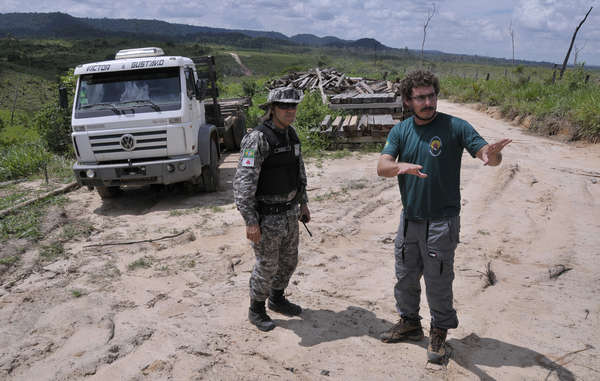
FUNAI agents in Brazil. Ground teams work full-time to keep invaders out of uncontacted tribal territory, but this vital protection could be withdrawn.
© Mário Vilela/FUNAI
The proposals are the latest in a long list of actions from the Temer government, which came to power in 2016 after the impeachment of Dilma Rousseff, that could have catastrophic consequences for indigenous peoples.
Indigenous activist Sonia Guajajara said: “By cutting down the FUNAI budget, the government is declaring the extinction of indigenous people.”
Paulo Marubo, an indigenous man from the Javari Valley in Brazil’s Amazon said: “If the protection teams are withdrawn, it will be like before, when many Indians were massacred and died as a result of disease… If the loggers come here, they will want to contact the uncontacted, they will spread diseases and even kill them.”
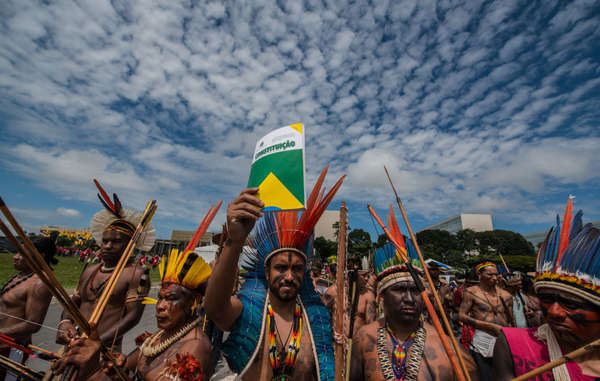
Indigenous protestors in Brasilia, Brazil.
© Fabio Nascimento / Mobilização Nacional Indígena
Campaigners have suggested that the government’s close ties to Brazil’s powerful ranching and agribusiness lobbies – which consider indigenous territories to be a barrier to their own expansion – could be part of the reason for the proposal.
Major indigenous protests are taking place this week in Brasilia against government proposals to water down protection for indigenous rights.
Uncontacted tribes are the most vulnerable peoples on the planet. Whole populations are being wiped out by violence from outsiders who steal their land and resources, and by diseases like flu and measles to which they have no resistance.
Survival International is leading the global fight for uncontacted tribes’ right to their land, and to determine their own futures.
Survival’s Director Stephen Corry said: “Cuts in government budgets to protect uncontacted tribes are clearly nothing to do with money – the sums involved are tiny. It’s a political move from agribusiness which sees uncontacted tribes as a barrier to profit and is targeting rainforest which has been off-limits to development. The reality is these cuts could sanction genocide.”
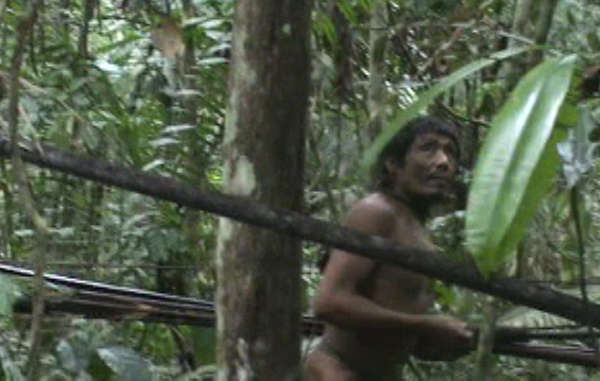
by Deep Green Resistance News Service | Apr 11, 2017 | Colonialism & Conquest
Featured image: The last of the Kawahiva are forced to live on the run. Still image from unique footage taken by government agents during a chance encounter. © FUNAI
by Survival International
Survival International has learned that politicians from a notoriously violent town in Brazil are lobbying behind the scenes to open up the territory of a vulnerable uncontacted tribe.
Councilors from Colniza in central Brazil, which is dominated by illegal logging and ranching and for years was Brazil’s most violent town, have met the Minister of Justice to lobby for the Rio Pardo indigenous territory to be drastically reduced in size. The minister is reportedly sympathetic to the councilors’ proposals.
Their plan is for road-builders, loggers, ranchers and soya farmers to move in, despite the territory being home to the last of the Kawahiva tribe, one of the most vulnerable peoples on the planet.
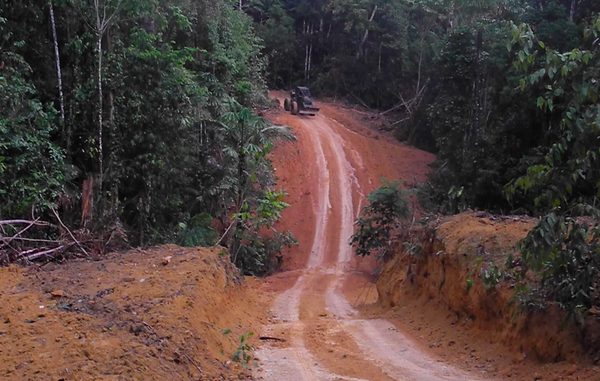
Armed loggers and powerful ranchers are razing the Kawahiva’s forest to the ground. © FUNAI
The Kawahiva depend entirely on the rainforest for survival, and have been on the run from loggers and other invaders for years.
The Rio Pardo territory was only recognized in 2016, following a global campaign by Survival International and pressure within Brazil.
Thousands of Survival supporters contacted the then-Minister of Justice demanding action. Oscar-winning actor and Survival ambassador Sir Mark Rylance fronted a major media push, culminating in the signing of the decree that should have secured the Indians’ territory for good.
Now, however, vested interests in the region could undo much of that progress.
Survival’s Director Stephen Corry said: “Brazil must respect the rights of its tribal peoples. Uncontacted peoples, like the Kawahiva, clearly want to be left alone and to live as they please. But Brazil’s current leaders are holding closed-door meetings with corrupt politicians, and kowtowing to the agribusiness lobby, expressly to deny them that right. The stakes could not be higher – entire peoples are facing genocide as a result of this callous approach.”
Background briefing
The Kawahiva are hunter-gatherers, who migrate from camp to camp through the Rio Pardo rainforest.
Roads, ranches and logging all risk exposing them to violence from outsiders who steal their lands and resources, and to diseases like flu and measles to which they have no resistance.
All uncontacted tribal peoples face catastrophe unless their land is protected. Survival International is leading the global fight to secure their land for them, and to give them the chance to determine their own futures.
The current Brazilian government is attempting to roll back decades of gradual progress in the recognition of indigenous peoples’ rights in the country. The Minister of Justice recently said: “Enough of all this talk of land [demarcation] – land doesn’t fill anyone’s stomach.” And the new head of Indigenous Affairs Department FUNAI has said “Indians can’t be ‘fixed in time.’”
by Deep Green Resistance News Service | Mar 30, 2017 | Colonialism & Conquest
Featured image: Dozens of people have been shot on sight by park guards in Kaziranga, including severely disabled tribal man Gaonbura Killing. © BBC
by Survival International
Survival International has called on the UN expert on extrajudicial executions to condemn shoot on sight conservation policies.
In a letter to the Special Rapporteur charged with the issue, Survival stated that “shoot on sight policies directly affect tribal people who live in or adjacent to ‘protected areas’… particularly when park guards so often fail to distinguish subsistence hunters from commercial poachers.”
The letter adds that “nobody knows when wildlife officers are permitted to use lethal force against [suspected poachers], and it is impossible for dependents to hold to account officers whom they believe to have killed without good reason. Many countries have gone further, and granted wildlife officers immunity from prosecution.”
The letter cites Kaziranga National Park in India as an especially striking example of the tactic. According to a recent BBC report, an estimated 106 people have been extrajudicially executed there in the last 20 years, including one disabled tribal man who had wandered over the park boundary to retrieve cattle.
Kaziranga guards have effective legal immunity from prosecution, and have admitted that they are instructed to shoot poaching suspects on sight. This has had serious consequences for tribal peoples living around the park. In June 2016, a seven-year-old tribal boy was shot and maimed for life by guards.

Akash Orang is comforted by his mother after being shot by a park guard. He is now severely disabled. © BBC
Similar policies are used in other parts of the world, notably Kenya, Tanzania and Botswana, among other African countries.
Speaking about his own anti-poaching work in Africa, poaching expert Rory Young from the organization Chengeta said: ”Shoot on sight is stupid. If we had been shooting on sight during this latest sting operation we would have shot a handful of poachers and that would have been the end of it. Every single poacher is an opportunity for information to get more poachers and work your way up the chain to the ringleaders.”
Survival has asked the Special Rapporteur to clarify that shoot on sight violates fundamental rights enshrined in the UN’s Civil and Political Rights Covenant and other international conventions. It also urges the UN to enquire about the policy with the Indian government, and the government of Assam state, where Kaziranga is located.
Shoot on sight is justified on the grounds that it helps to deter poachers. However, there have been several recent cases of guards and officials at Kaziranga being arrested for involvement in the illegal wildlife trade themselves.
Survival International is leading the fight against these abuses, and calling for a new conservation model that respects tribal peoples. Targeting tribal people diverts action away from tackling the true poachers – criminals conspiring with corrupt officials. Targeting tribal people harms conservation.
Survival’s Director Stephen Corry said: “If any other industry was guilty of this level of human rights abuses, there would be an international outcry. Why the silence when conservationists are involved? Torture and extrajudical killing is never justified – the law is clear on this. Some people think that the death of innocents is justified, that ‘collateral damage’ is necessary in the fight against poaching. We ask them, where is your humanity? Of course, there’s a racist element at play here: Shoot on sight policies would be unthinkable in North America or Europe.”
















